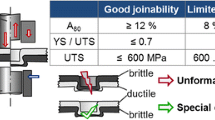Abstract
Body structure projects are designed to develop lightweight structures, which result in low fuel consumption and emissions for internal combustion engines and longer battery life in the case of electric vehicles. The structures need to be lightweight but also strong in order to provide maximum safety to the occupants. These premises have led to the development of special materials such as the hot stamping steels. The most used steel in this process, quenched 22MnB5, also exhibits the bake hardening effect: its yield stress increases after being exposed at temperatures close to 200 °C (typical heat treatment of paint lines in the automotive industry). The aim of this study was to verify the improvement in the mechanical strength of a body structure due to the bake hardening effect to which the hot-stamped steel components were submitted. Samples of annealed 22MnB5 steel were submitted to tensile and chemical analysis. A second group of the same steel was subjected to an additional heat treatment in a laboratory furnace simulating the heating that occurs in the body paint line. Subsequently, the same tests were performed with the samples from the first group. Tensile tests evidenced the increase of 6.5% in the yield stress of the samples that suffered the bake hardening effect. The stress-strain diagram curves were used as the input to the side crash simulation program. The simulations demonstrated that the body structure whose hot-stamped parts were subjected the bake hardening effect had a 2% reduction in side crash intrusion compared to body structure where the parts did not suffer this effect. In the case of the lateral protection bar test, the bake hardening effect provided a 5% increase in the maximum bending load.
Similar content being viewed by others
References
Alsmann M (2013) Warmumformung – Herstellung höchfestersicherheits-relevanter Strukturbauteile. Seminary Volkswagen A.G, Merseburg (Germany)
Blanter, M.; Neuhäuser, H.; Golovin, I.; Sinning, H.; Internal friction in metallic materials. Springer, Berlim – Heidelberg (Germany), 2007
Cooman B, Fan D (2011) State-of-the-knowledge on coating systems for hot stamped parts. Steel research international, Weinheim (Germany)
Cooman, B.; Kwon, H.; Choi, W.; Lee, J.; Bake hardening analysis of 22MnB5 PHS by the impulse internal-friction. Hot sheet metal forming of high-performance steel congress. Toronto (Canada), 2015
Davies G (2012) Materials for automobile bodies, 2nd. edn. Elsevier, Waltham (United Kingdom)
Gorni, A. Novos aços ferríticos garantem alta resistência e conformabilidade a chapas finas laminadas a frio. Corte e Conformação Magazine, Aranda, São Paulo (Brazil), 2010 (in Portuguese)
Hayakawa, M.; Kajita, T; Jeszensky, G. Análise química de aços por espectrometria de emissão ótica. Sorocaba (Brazil), 1980 (in Portuguese)
Hosford WF, Caddell RM (2011) Metal forming mechanics and metallurgy. New York (USA), Cambridge
Karbasian H, Tekkaya AE (2010) A review on hot stamping. Journal of Materials Technology, Elsevier, Dortmund (Germany)
Lundström E (2013) 30-year experience in press hardening. Seminary Schuler Press, São Paulo (Brazil)
Malen DE (2011) Fundamentals of automobile body structure design. SAE International, Warrendale (USA)
Meyers M, Chawla K (2010) Mechanical behavior of materials, 10ª. edn. New York (USA), Cambridge
Prado GI, Pereira EA, Lacerda RM (2013) Comparative analysis of side impact tests, tendencies and challenges for Brazilian market. Congress SAE, São Paulo (Brazil)
Ritchie, I. G., Mathew, P. M., Pan, Z. I. Osborne, C. and Prikryl, J. K., Mechanical relaxation spectroscopy in steel wire research. Wire Journal International p 201–218, 1989
Rodrigues Jr J., Influência das temperaturas de encharque e superenvelhecimento nas propriedades mecânicas de um aço ultra baixo carbono com características BH processado via recozimento contínuo. Master of Science paper. Federal University of Minas Gerais, Belo Horizonte (Brazil), 2010 (in Portuguese)
U.S. Department of Transportation. Federal motor vehicle safety standards – evaluation, Virginia: National Technical Information Service, 1999 (FMVSS 214)
Acknowledgements
The authors would like to thank Energetic and Nuclear Researches Institute—IPEN, Volkswagen do Brasil, Volkswagen Kassel (Germany), Schuler Presses, Usiminas, Gestamp, and Benteler.
Author information
Authors and Affiliations
Corresponding author
Rights and permissions
About this article
Cite this article
de Castro, M.R., Monteiro, W.A. & Politano, R. Enhancements on strength of body structure due to bake hardening effect on hot stamping steel. Int J Adv Manuf Technol 100, 771–782 (2019). https://doi.org/10.1007/s00170-018-2542-4
Received:
Accepted:
Published:
Issue Date:
DOI: https://doi.org/10.1007/s00170-018-2542-4




